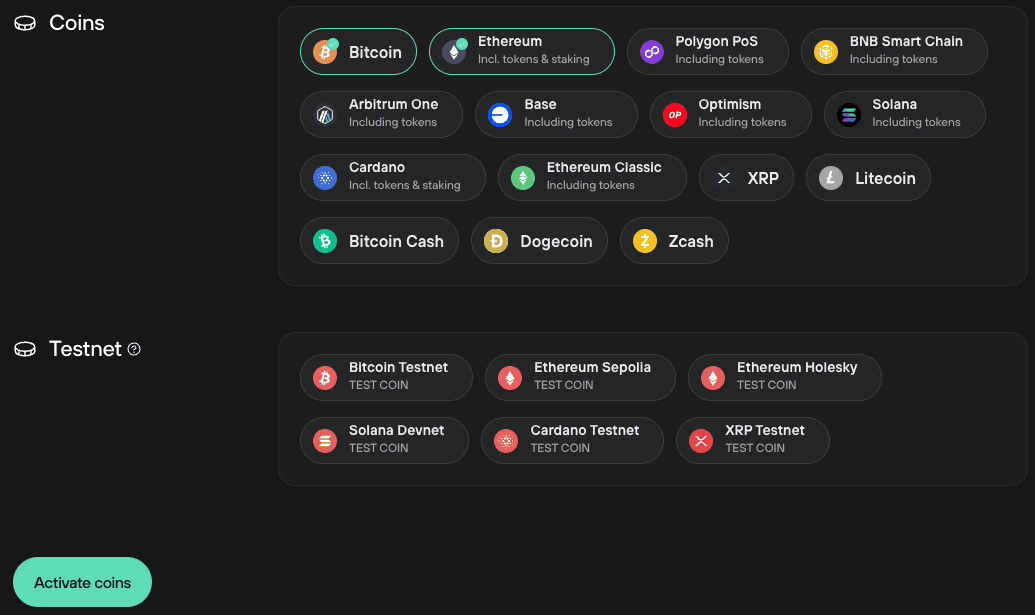Trezor Suite settings
The settings menu can be used to configure basic Trezor Suite and device (Trezor Safe Family, Trezor Model T, Trezor Model One) settings once your device is set up.
Accessing the settings menu in Trezor Suite
To access the settings menu in Trezor Suite, click on Settings in the left-hand menu bar:
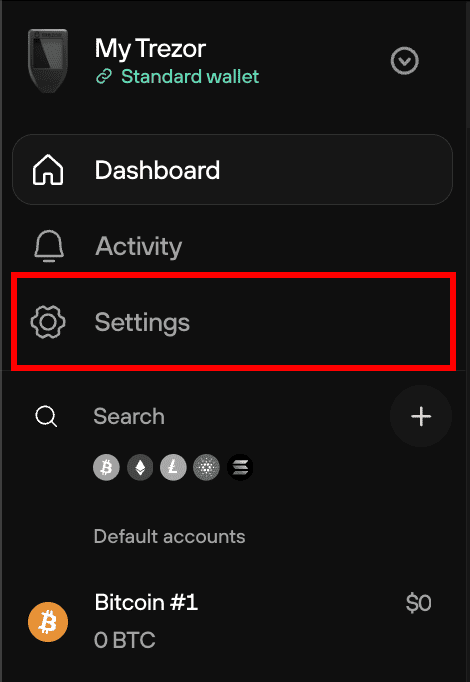
You will then be taken directly to the Settings menu, where you can readily change Application, Device, or Coins settings by switching to the relevant tab:
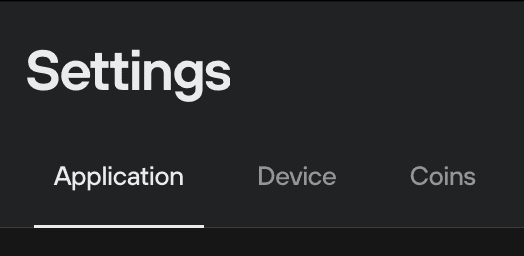
Application settings
The application settings menu can be used to personalize your Trezor Suite experience.
Localization

Language: the default language for Trezor Suite is English, or if available, the language set in your computer settings. You can also switch to the following languages:
- English
- Spanish
- Czech
- German
- French
- Italian
- Brazilian Portuguese
- Turkish
- Hungarian (community translation)
- Japanese (Beta) (community translation)
- Russian (community translation)
- Ukrainian (community translation)
- Simplified Chinese (community translation)
Fiat currency: choose which currency Trezor Suite should use when representing cryptocurrency balances in fiat denominations.
Bitcoin units: customize how Trezor Suite displays your Bitcoin balances by choosing either Bitcoin or satoshis (you can also toggle between the two units by clicking on the balances displayed in Trezor Suite)
Labeling

Labeling: use the switch to toggle the feature on/off. Labeling lets you rename your wallets, accounts, and addresses. Labels are applied by syncing with Dropbox or Google Drive, or can be stored locally on your computer.
Tor

Tor: use the switch to toggle Tor on or off.
Open trezor.io links as .onion links: when enabled, trezor.io links will be opened as .onion links.
Application
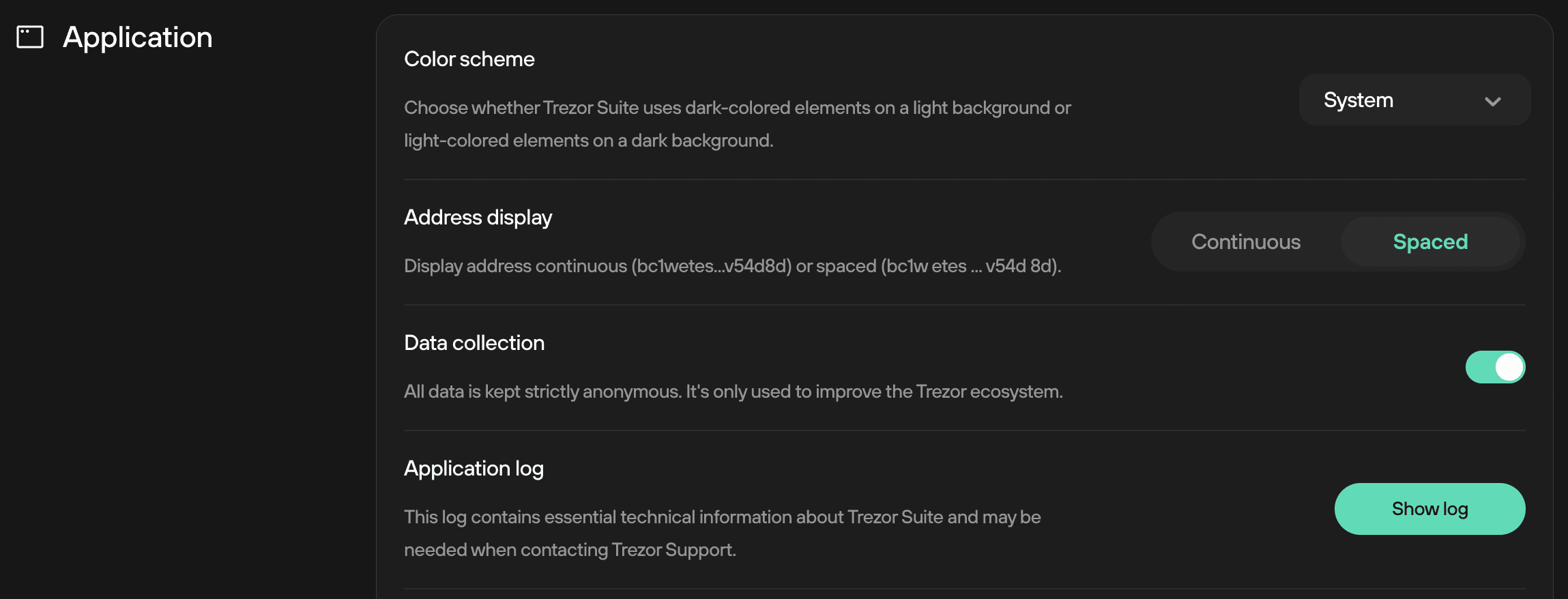
Color scheme: set the Trezor Suite color scheme to light, dark, or to mirror your system settings.
Address display: choose between "Continuous" or "Spaced" address formats, the latter of which presents them in user-friendly chunks of 4 characters. Having the option to switch between the two formats aims to simplify and enhance the address verification process.
Usage data: use the switch to toggle submission of user data on/off. Any data you provide is anonymous, and is used solely for the purpose of improving Trezor products.
Application log: click "Show log" to display all necessary technical information, should you need to provide it to the Trezor support team.
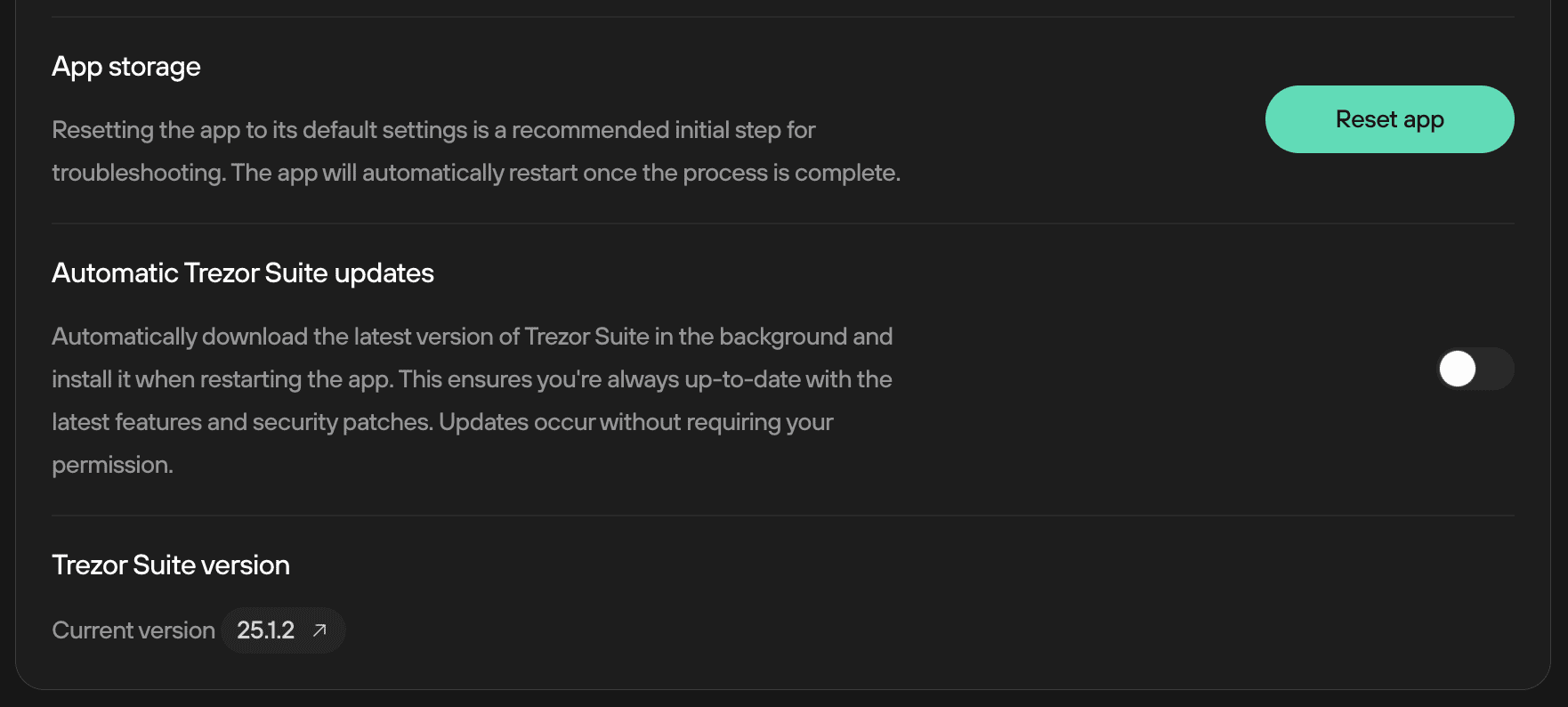
App storage: click 'Reset app' to revert to the Trezor Suite default settings. This may be useful if you're trying to troubleshoot any problems.
If you are already using your Trezor and reset the app, you will need to reauthenticate your Trezor (confirm that you have previously used it) afterward and reload your Trezor wallet balance(s).
Note that when Trezor Suite restarts after a reset, the only enabled coin is Bitcoin. To view balances of other coins you may already hold on Trezor, please navigate to Settings again and select the "Coins" tab then click on each of your coins to reenable them (as explained below).
Automatic Trezor Suite updates: use the switch to allow Trezor Suite whenever an update is available to automatically download it in the background and then install it the next time you restart the app.
Suite version: here you will see the version of Trezor Suite you currently have installed on your computer. Click on the version number to view the corresponding Trezor Suite github project. If an update is available, click on "Get the latest version" to update Trezor Suite on your computer.
Privacy
Auto-eject wallets: Turn on to eject all wallets from Trezor Suite when you disconnect your Trezor. With this setting turned off, you can view wallet balances even after disconnecting your Trezor device (previously referred to as view-only mode).

Experimental
Early Access Program: an opt-in feature that will deliver beta versions of new updates a week before their planned release date.

Experimental features: test Trezor Suite developments and features prior to wider public release:

Device settings
Use the device settings menu to customize your Trezor device, manage security features, and perform other (advanced) operations.
Wallet backup
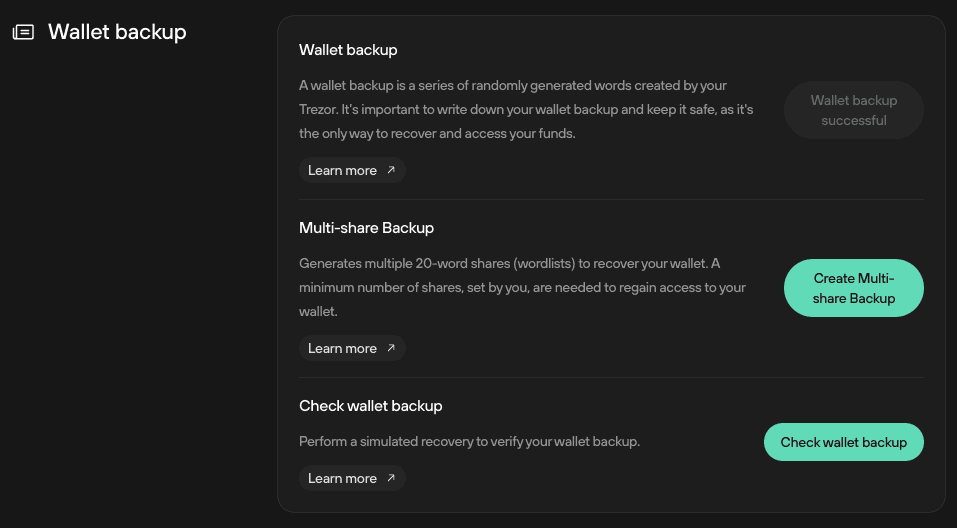
Wallet backup: informs you of the status of your backup, i.e., whether or not you've set up your wallet backup (formerly recovery seed).
If you've already created your backup, you'll see the grayed-out "Backup successful" button.
If you have not already created your backup, please click on Create backup and set it up as soon as possible:
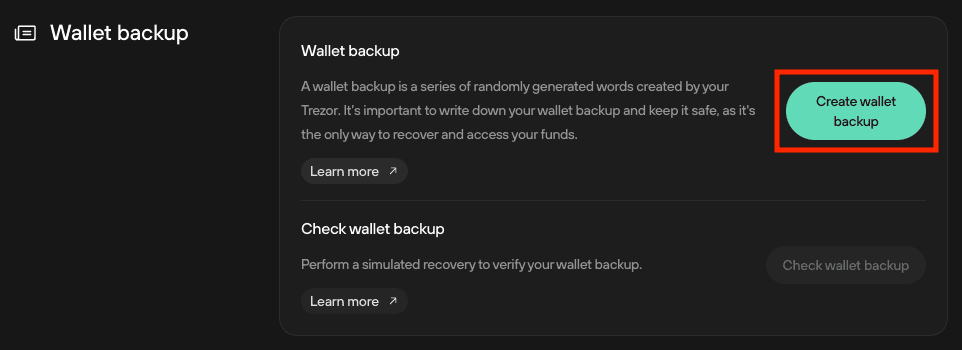
If you are using your Trezor device without a wallet backup, Trezor Suite will also display a red banner at the top of the screen, prompting you to create a backup.
- Create Multi-share Backup: allows you to create a multi-share backup. Note that this option only appears if the backup you are using with your Trezor is a single-share or multi-share backup (the list(s) of words is 20 or 33 words in length).
- Check wallet backup: click on 'Check wallet backup' to perform a simulated wallet recovery process, which allows you to check the validity of your wallet backup.
A step-by-step guide for checking your wallet backup is also available for all Trezor models:
Turn passphrase protection on or off.
Turn the passphrase feature on or off here. When it’s off, Trezor Suite hides the + Passphrase option in the wallet switcher, and the Standard wallet is loaded by default.
Firmware

Firmware version: informs you which firmware version is currently installed. Click on the version number to view the corresponding Trezor firmware github changelog.
Type: informs you which firmware type is installed on your Trezor device, and allows you to switch between Universal and Bitcoin-only firmware (note that this process will wipe your wallet backup on Trezor Safe 5 and Safe 3). Click on the version type to view the corresponding Trezor Suite github project.
Language: Sets the language on your Trezor device. By default this is English or the system language of the computer you were using at the time of initialization were it available on the device firmware. You can switch to the following languages:
- English
- Czech (beta)
- German (beta)
- Spanish (beta)
- French (beta)
- Italian (beta)
- Portuguese (beta)
Security
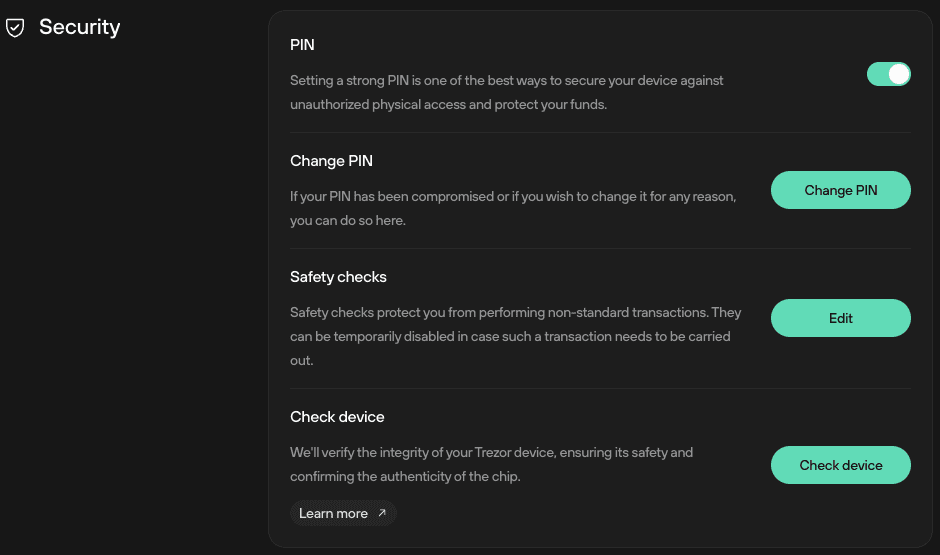
PIN: use the switch to toggle the PIN feature on/off. Change PIN: if you want to change your PIN (or need to change it because you suspect it may have been compromised) simply click on 'Change PIN' and follow the on-screen instructions. Safety checks: although not recommended, you can turn off Trezor safety checks and allow (potentially) unsafe actions, e.g. mismatching coin keys or enabling extreme fees.
Do not edit the safety checks unless you know what you're doing!
Check device (Trezor Safe 5 and Safe 3 only): reruns the device authentication check normally made during the initialization (setup) of the device in Trezor Suite.
Customization
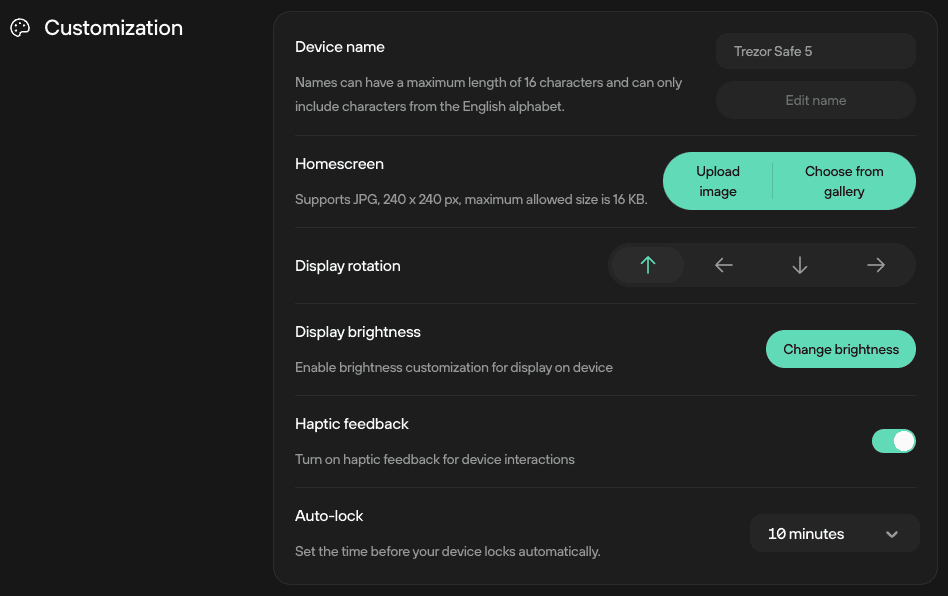
Device name: use the box to customize the name of your Trezor device. Homescreen (Trezor Safe 5 and Model T only): upload a custom image, or choose from the gallery, to personalize the homescreen of your Trezor device.
Display rotation (Trezor Safe 5 and Model T only): use the North / South / East / West buttons to rotate the display on your Trezor device accordingly.
Display brightness (Trezor Safe 5 and Model T only): allows the brightness of the Trezor Trusted Display (touchscreen) to be increased or decreased.
Haptic feedback (Trezor Safe 5 only): when enabled the device vibrates to confirm critical steps.
Auto-lock time: change how long it takes for the device to automatically lock.
When renaming your Trezor, or entering characters via the device touchscreen, only the following standard ASCII characters are valid:

Danger area
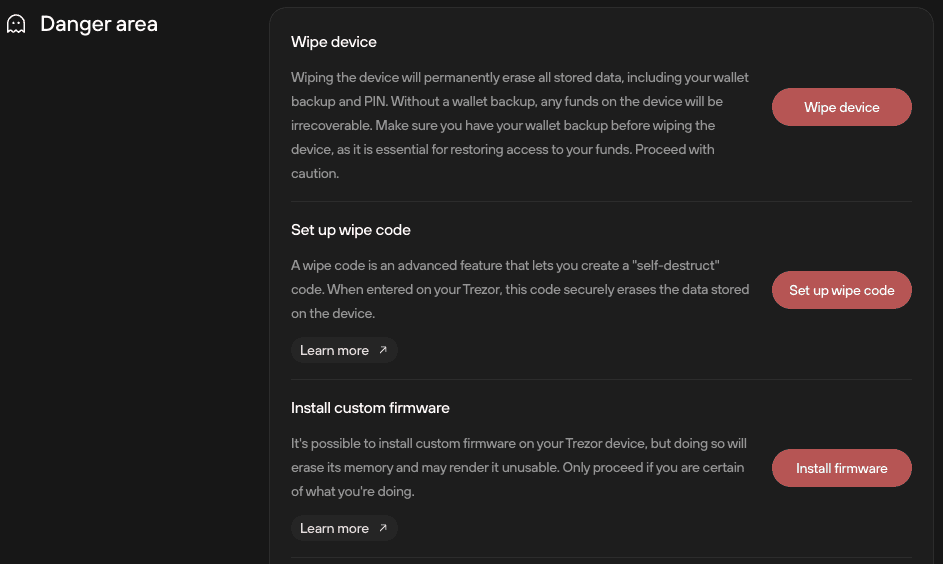
Factory reset/wipe device: perform a factory reset or wipe device process to erase the wallet backup information (and firmware, if factory reset) from your Trezor device.
Set up wipe code: use this advanced feature to create a "self destruct" code for your Trezor hardware wallet.
Install custom firmware: downgrade the device firmware or install bitcoin-only firmware.
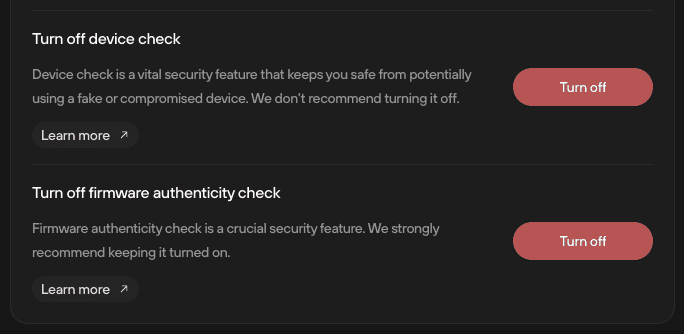
Turn off device check (Trezor Safe 5 and Safe 3 only): Disallows Trezor Suite from requiring a device authentication check be made during the initialization (setup) of the Trezor. It is not recommended to turn this feature off, for more information, see Trezor Safe device authentication check.
Turn off firmware authenticity check: Disables a set of verfication processes targeting counterfeit Trezor devices and firmware. These security checks should only be disabled for testing and development purposes. More information is available in our article Trezor firmware authenticity check.
Coins settings
Use the Coins settings area to enable or disable coins - just click on the coin in question.
Hover over an active coin to reveal the settings gear icon; click on it to access the "Backends" menu, which allows you to setup custom backends in Trezor Suite.
If you select additional coins here, click the green Activate coins button to display them among your accounts in Trezor Suite.
Disabling a coin only removes it from the Trezor Suite interface, it does not cause the coins to "disappear" from your device.
